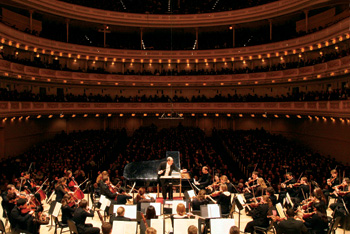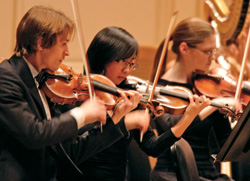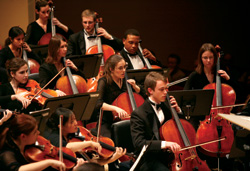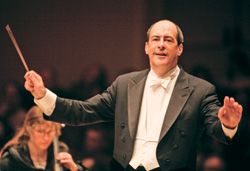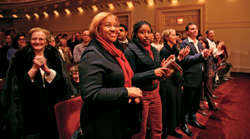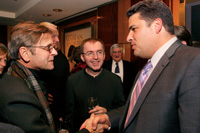
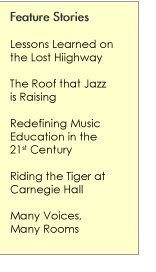
|
| Home :: Features :: Riding the Tiger at Carnegie Hall Riding the Tiger at Carnegie Hall By Kevin Filipski. Photos by Steve J. Sherman ’81.
In a note printed in the program for the Oberlin Conservatory Symphony Orchestra’s concert at Carnegie Hall on January 26, Dean of the Conservatory David H. Stull quoted John Philip Sousa on the power of live performance. “The nightingale’s song is delightful because the nightingale herself gives it forth,” Sousa said, and Stull pointed out that, thanks to continued lightning-quick advances in technology, the ability to transmit serious music to listeners around the globe is far easier than ever before. Yet nothing can compare to sitting in a storied auditorium like Carnegie Hall and hearing great musical artists perform great music. The Isaac Stern Auditorium was packed for what was a historic concert. After all, it had been a quarter century (1982, to be exact) since Oberlin students last performed on the fabled Carnegie Hall stage. This time, conductor Robert Spano ’83 led the orchestra through readings of three diverse works (Jennifer Higdon’s blue cathedral, Wolfgang Mozart’s Piano Concerto No. 25, and Béla Bartók’s Concerto for Orchestra) that wowed the notoriously hard-to-please New York critics. Vivien Schweitzer, reviewing the concert for the New York Times, described the performances as “dynamic,” “vividly illuminating,” and “stellar,” writing, “Mr. Spano has transmitted his excitement to the young musicians.” And Patrick J. Smith began his rave review for musicalamerica.com by stating: “It is always an exhilarating and heartening experience to hear a first-rate student orchestra under a sympathetic and experienced conductor give a concert of music that has been burnished by generations of professional ensembles—and come close to matching them for musicality while topping them for sheer youthful élan.” Judging from such accolades, 25 years was far too long an absence. A Little Night Music
Maestro Spano discussed the genesis of the orchestra’s program. “We wanted to do a program that the orchestra could take on the road, as well as one that made sense for the students’ musical diet,” he says. A desire to include a contemporary work by an American composer, the kind of music Spano is associated with, led to the inclusion of the concert’s opener, Jennifer Higdon’s blue cathedral, an atmospheric 10-minute work that shimmered brightly in the hall’s famed acoustics. Spano deftly shaped all of the varying moods with his tight ensemble, beginning with a funereal, quiet opening, then moving through ecstatic bursts of brass and strings to what the composer describes as a quiet finish of “peace and closure.” Throughout the work, there were spectacular contributions from the percussion, brass, and string sections. Next, the students were happy to defer to Serbian pianist Pedja Muzijevic, who played the complex solo part in Mozart’s Piano Concerto No. 25, including the infrequently played first movement cadenza by Mozart contemporary Philipp Karl Hoffmann, which Muzijevic made integral to the piece. The orchestra’s woodwinds made the most of the lovely melodies in the second movement, and Spano and the students underscored Mozart’s elegant orchestrations during the melancholy allegretto finale. By universal agreement, the best was saved for last: Bartók’s Concerto for Orchestra. “It’s really great music!” exclaims Spano when asked why the Bartók masterpiece sounded so stirring that night. “It is music that calls upon something in us to meet it at its highest level.” That all involved certainly did so is beyond question. Throughout the concert, Spano and the musicians were thoroughly swept up in the waves of affection and applause from a house filled to the rafters with Oberlin alumni, family, and friends. Spano believes that “the perfect storm” of this memorable evening happened because of the audience as much as the musicians. “Audiences always have everything to do with everything,” he says. “They have as much to do with a good performance as the performers. It was such a special night because of that—it was Oberlin Reunion Night!” Impresarios
How did this epochal evening originate? “The dean [David H. Stull] really made this happen,” says Spano, who is Music Director of the Atlanta Symphony Orchestra and Professor of Conducting at Oberlin, currently on leave. “I’d been trying to do something at Oberlin for the past few years because I hadn’t been back there in awhile. And he came up with the idea of doing a concert at Carnegie Hall.” Stull concurs. “Bob and I were chatting several years ago about ways that we could do a project together, and this was an opportune time to bring him back,” he says. “Bob was excited by the idea of conducting the student orchestra at Carnegie Hall. He’s an imaginative, phenomenal conductor and a terrific teacher. He also has great flair for devising programs that challenge the students to do their best work.”
Without the support of Jolyon F. Stern ’61, however, Stull and Spano’s conversation would have been nothing more than wishful thinking. Stern, the president and CEO of the DeWitt Stern Group, underwrote the concert and was honored with an acknowledgement during Stull’s on-stage introductory remarks. “As a College, we have always aspired to imbue all of our graduates with a sense of purpose that extends beyond a passion for achievement and a desire for excellence,” Stull told the audience. “At the center of Oberlin is the belief that each graduate should not only seek great success in his or her life, but also aspire to develop the character required to make the world a better place—whether that be through courageous action, bold endeavor, intellectual pursuit, financial support, or the sharing of great music.
“Tonight’s concert would not have occurred if it were not for the support of an individual who represents exactly that kind of character,” Stull added. “I am referring to the remarkable gentleman who funded this evening’s performance, Jolyon Stern.” Practice, Practice, Practice According to numerous accounts, the Carnegie Hall performance was far superior even to the terrific performance of the same program at Finney Chapel on the Oberlin campus two days before the New York City appearance. Of that concert, Donald Rosenberg of the Plain Dealer wrote: “The Oberlin ensemble was first-rate in every instrumental section.” The students’ intensive preparation with Oberlin Director of Orchestras Bridget-Michaele Reischl for the two weeks prior to Maestro Spano’s appearance on campus was instrumental in ensuring that the musicians were already well versed in the program when he took over. Thanks to three weeks’ worth of rehearsals that culminated in the Finney Chapel concert, the Carnegie performance that followed was a true revelation, even to the students onstage. Horn player Jeffrey Staulcup ’08 sums it up: “It took the whole week for the orchestra to absorb (Spano’s) style of conducting, his energy and excitement. Each rehearsal was a struggle, but the magic was slowly developing each day. The Carnegie Hall concert was completely different from any of the rehearsals or the Oberlin performance, and it really exploded by the end of that performance.” Cellist Steuart Pincombe ’09 and trumpet player Avi Bialo ’07 agree. “The main thing for us was that he had such excitement for the music, and we recognized his love for it and rose to that level because of how he was reacting,” Pincombe explains. About the Bartók piece, Bialo says, “I got compliments from people who said it was by far the most exciting performance of the evening. I was really honored to hear that because, after all, there are so many recordings of the concerto out there to choose from. But for us in a student orchestra, this is still kind of new, and there was a definite adrenaline factor at work for all of us, since we were all nervous about our first concert together at Carnegie Hall.” Spano had no doubts that the revelatory performance of Bartok’s Concerto for Orchestra was well within the orchestra’s sights from the beginning. “After the rehearsal on the morning of the Carnegie concert, I talked to the musicians for, what for me, was quite at length, since I don’t normally talk that much!” he admits. “I talked about the concert at Oberlin and how it could be different or even better when we performed at Carnegie. “I believe that all performers have to find their own ways to manage and to utilize the pressure, which needs to become a servant rather than a master. Then I told them to ‘ride the tiger!’” he laughs. Kevin Filipski is a New York-based writer who has covered the arts for such publications as the New York Times and Playbill. |
